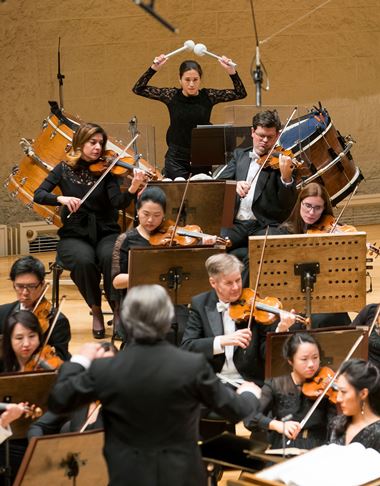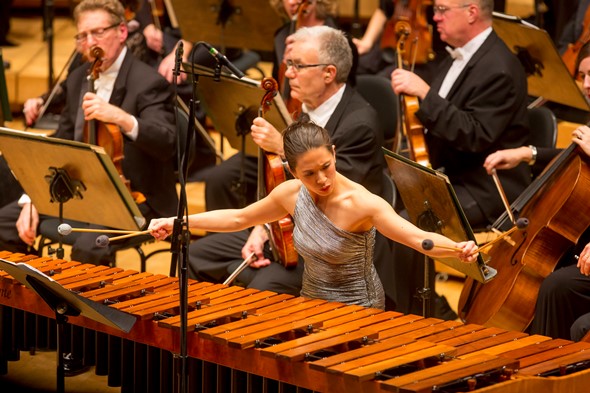CSO percussionist needs fast hands, and feet, to cover the challenge of a wild new concerto
Interview: Cynthia Yeh says she has mapped out her steps to cover wide array of instruments in Avner Dorman’s “Eternal Rhythm.”
By Nancy Malitz
If there is anyone in the Chicago Symphony Orchestra whose onstage attire should include a pair of sneakers, it is principal percussionist Cynthia Yeh, who will be at the center of attention for three concerts Oct. 3-5 as the soloist in the widely anticipated U.S. premiere of Avner Dorman’s free-wheeling concerto “Eternal Rhythm.”

Normally she’s at the back of the stage, but Cynthia Yeh will come front and center for a new concerto. (Todd Rosenberg)
The percussion concerto, laid out in five wildly contrasting sections, arrives here fresh from its world premiere in Hamburg. Much of the work bubbles forward in seeming perpetual motion, and Yeh will move around as she stations herself at various instrument groups arranged in pre-set arm’s length arrays. As each of these sound groups joins the din, time flies, and so must she.
Over a busy summer schedule that kept her on the go, Yeh managed to stay focused on getting Dorman’s dazzling piece into her head and fingers.
“I spent every minute I could just cramming and learning and working out the details of how I was going to get Avner’s music played,” she says. “And to be honest, because of the way percussion concertos are written, I couldn’t be practicing the whole thing through end-to-end in a flow anyway. It was a matter of hitting it movement by movement, instrument cluster by instrument cluster.”
Dorman, 44, is an Israeli-American composer who trained at Juilliard with John Corigliano, teaches in Pennsylvania, and enjoys a broad network of connections on both sides of the Atlantic. He has an opera under his belt, a mandolin concerto, several other works for percussion, and performance credits from major orchestras in Vienna, San Francisco, Los Angeles, New York, Munich and Tel Aviv.
Despite the mathematical complexity of the concerto’s rhythms as they look on paper, Yeh says she thinks “Eternal Rhythm” will seem “almost free of time actually. It will have a rubato feel. When I talked to Avner about this, he explained that for most of it, even though it is precisely written, he felt that for him it was his own best way of dictating beats that don’t divide equally into twos or threes or eights or nines.
“So I think this is an important distinction, that just because it looks difficult doesn’t mean it’s too hard to understand. Sometimes I feel like new music gets a bad reputation that way. This piece is extremely accessible, extremely tonal in the European tradition – and it’s actually melodic, too, because basically every percussion instrument I’m playing in this piece is a pitched instrument. The only things un-tuned are the tin cans. Even the tom-toms become quite melodic.”
Referring to a recording documenting the Hamburg premiere, Yeh lauded the balance Dorman has achieved between soloist and orchestra. “You can definitely hear everything in the solo part – and believe me, marimba and vibes are drownable if the orchestra is too loud!”
Dorman has actually written two versions of this concerto. In one, the soloist is given the option to sing an 11th-century philosophical ode in Hebrew on the nature of death, which asks, “Does a tear know whose cheek it runs down, or the heart by whom it is turned?” It’s soaring, cantorial stuff; many cantors have huge pitch spreads, like opera singers.
These performances will mark the world premiere of Dorman’s strictly instrumental version, says Yeh. “I’m not a singer with this kind of a vocal range! But I will play it cantorially.” Yeh hears the jazz influence in Dorman’s sound world, too. “Jazzish chords, definitely, in places. And the music can also be gamelan-y,” she says of some Southeast Asian influence. “The fast movements really rock out in a way. I think of it as a kind of mish-mash. He draws from everything.”
Yeh is famously accurate and strong, with unmatched endurance, a reputation seemingly belied by her petite size. In May of 2018, at the Art Institute of Chicago, I watched in disbelief as Yeh multi-tasked on marimba-like wooden planks with her right hand and both feet, while sustaining the equivalent of a continuous left-handed drum roll for what seemed like 20 minutes. It was a piece called “Memory Palace” by Chris Cerrone, which proved, true to its title, unforgettable.
“You didn’t see him but also there was my physical therapist and massage therapist,” Yeh recalls. “If my acupuncturist could have, she would have been there, too. It’s all for injury prevention. Because if you play the double bass or the cello, your body gets used to that one position, for better or for worse. But with percussion, it’s always something different – unnatural twists and turns and reaches you’re suddenly doing over and over, and your hands doing weird things, too. Believe it or not, this concerto takes more of a toll on my IT (iliotibial) bands down the side of my legs than the Cerrone did. But my arms and shoulders are pretty much fine.”
In the days prior to the Dorman rehearsals, Yeh set herself up to work out exactly how she wanted to place the instruments: “This concerto follows the formula of some other concertos I played in that there’s a marimba station, and also a vibraphone station, and an un-pitched drummy section, and you go around between the stations.
“So it’s a matter of physically figuring out how to get to my next station in four beats and switch mallets while doing it, pacing out the walk. Things like that – in three-inch heels, of course. Some things I won’t compromise on! But I do need to practice it. The hard part is figuring out where to put things because I don’t have much wingspan.”
The next step is the performance. Yeh says the title refers to something Avner calls the ever-present energy of life itself: “That’s the kind of rhythm that I sense throughout. But we’ll see what the audience thinks.”
Related Link:
- Performance and ticket info: Details at cso.org



